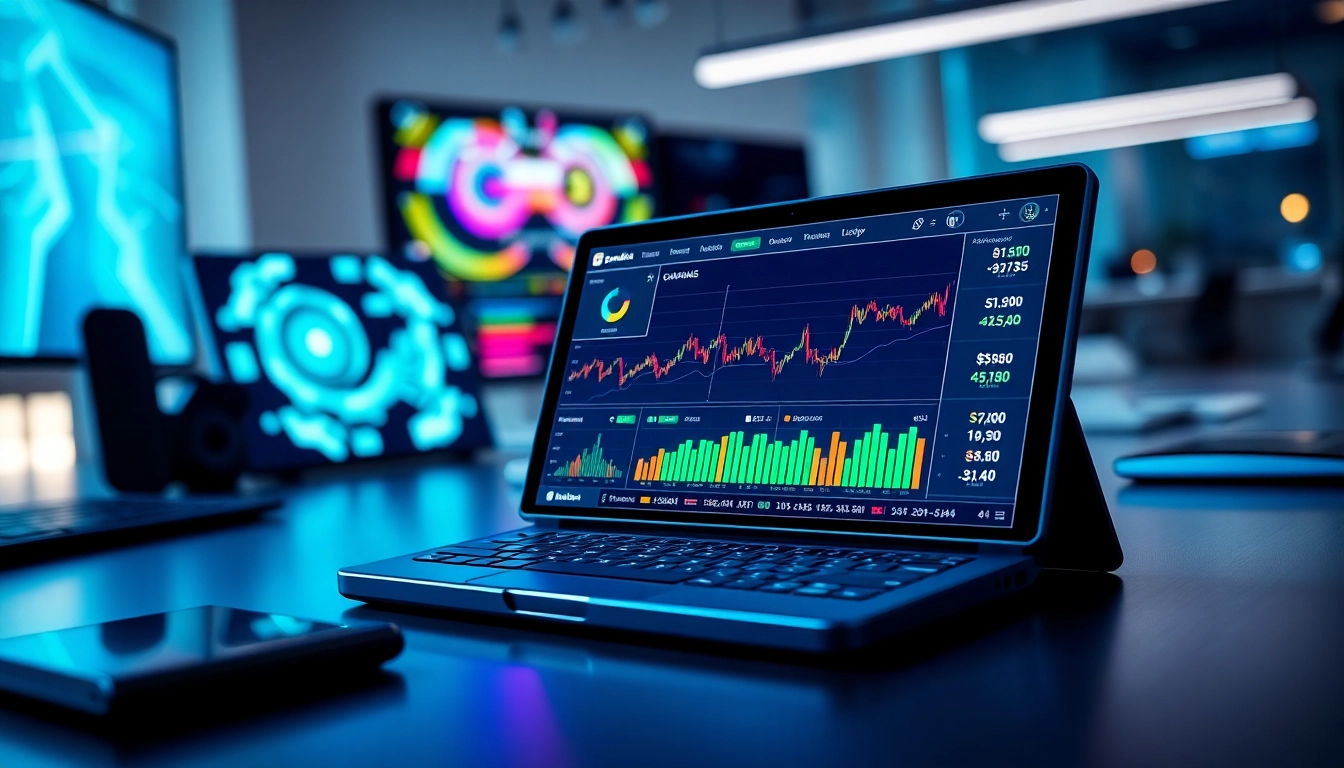Understanding the Basics of Forex Trading
What is Forex Trading?
Forex trading, also known as foreign exchange trading, involves the buying and selling of currencies in the global marketplace. It operates on a decentralized basis, meaning that traders engage with one another through electronic networks rather than centralized exchanges. With a daily trading volume exceeding $6 trillion, the Forex market is the largest and most liquid financial market globally. This high volume and liquidity provide traders various opportunities to profit from market movements.
Forex trading is often associated with high risk but also offers high rewards for those who are knowledgeable and disciplined. Traders aim to capitalize on fluctuations in currency pairs, such as the euro versus the US dollar (EUR/USD), to make a profit. The value of currencies can change based on a variety of factors, including economic indicators, geopolitical events, and market sentiment.
As you delve into the world of Forex Trading, you’ll find that understanding how markets operate, the types of trading strategies available, and the inherent risks involved is crucial to becoming a successful trader.
The History and Evolution of Forex Trading
The Forex market’s history traces back to ancient times when the first currency exchanges were conducted through bartering systems. In the modern era, the Forex market began to take shape in the 1970s when countries floated their currencies in response to the collapse of the Bretton Woods Agreement. This shift to a floating currency system allowed currencies to fluctuate freely according to market forces.
With the advent of technology, Forex trading has evolved significantly. The introduction of the internet allowed individual traders to access the Forex market, which was previously dominated by banks and large financial institutions. Today, powerful platforms and tools make it easier than ever for anyone to engage in Forex trading, whether for profit or hedging purposes.
Key Terminology in Forex Trading
To navigate the Forex market effectively, it’s essential to understand its vocabulary. Here are some of the key terms:
- Currency Pair: A currency pair consists of two currencies, where one is quoted against the other (e.g., EUR/USD).
- Bid and Ask Price: The bid price is what buyers are willing to pay for a currency, while the ask price is what sellers are willing to accept.
- Pips: A pip is the smallest price move that a given exchange rate can make, usually the fourth decimal place in a currency pair.
- Spread: The spread is the difference between the bid and ask price.
- Leverage: Leverage allows traders to control larger positions than their initial capital would allow, amplifying both potential profits and losses.
How Forex Trading Works
Market Structure and Participants
The Forex market operates 24 hours a day, five days a week, divided into different trading sessions (Asian, European, and North American). This structure allows traders worldwide to participate regardless of their time zone.
The main participants in the Forex market include:
- Central Banks: They manage and implement monetary policy, influencing currency values through interest rates and interventions.
- Commercial Banks: They facilitate international transactions, contributing significantly to the daily trading volume.
- Corporations: Businesses engaged in international trade use Forex to hedge against currency fluctuations.
- Retail Traders: Individuals trading for personal profit make up a growing portion of the market.
Currency Pairs and Quotes
Currency pairs are categorized into three main types:
- Majors: These include the most traded currencies, such as EUR/USD, USD/JPY, and GBP/USD.
- Minors: Pairs that do not include the US dollar, such as EUR/GBP and AUD/NZD.
- Exotics: These pairs involve a major currency and a currency from a developing country, like USD/THB (Thai Baht).
The quote for a currency pair reflects the value of one currency in terms of another. Understanding these quotes and how to interpret them is vital for successful trading.
Understanding Forex Trading Platforms
Forex trading platforms are software applications that allow traders to place trades, access market data, and execute orders. When choosing a platform, consider the following features:
- User Interface: A well-designed interface enhances the trading experience and makes it easier to assess market conditions.
- Charting Tools: Look for platforms that offer charting tools and technical analysis indicators to help make informed trading decisions.
- Execution Speed: Effective trade execution is crucial, especially in a fast-paced market like Forex.
- Support and Resources: A platform that provides adequate resources, including educational materials and customer support, can improve your trading journey.
Strategies for Successful Forex Trading
Analysis Techniques: Fundamental vs. Technical Analysis
Two primary approaches to analyzing Forex markets are fundamental and technical analysis.
Fundamental Analysis: This technique focuses on economic indicators, such as GDP growth, employment rates, and monetary policy shifts. By understanding the economic landscape, traders can make predictions about currency movements based on fundamental data.
Technical Analysis: This approach relies on charts and technical indicators to identify trading opportunities. Traders analyze historical price patterns and use tools like trend lines, moving averages, and oscillators to predict future price movements.
Risk Management in Forex Trading
Effective risk management is essential for long-term success in Forex trading. Here are some best practices to consider:
- Setting Stop-Loss Orders: A stop-loss order automatically closes a position when the price reaches a specified level, helping to limit potential losses.
- Position Sizing: Determine the size of each trade according to risk tolerance and account balance to ensure that no single trade can significantly affect your total capital.
- Diversification: Spread your investments across various currency pairs to mitigate risk.
Developing a Personalized Trading Strategy
A successful trading strategy should align with your individual goals, risk tolerance, and trading style. Consider the following steps when developing your strategy:
- Set Your Goals: Define your financial objectives and the amount of time you can commit to trading.
- Choose Your Trading Style: Determine whether you are interested in day trading, swing trading, or position trading, each having its unique approach and time commitment.
- Backtest Your Strategy: Test your strategy using historical data to assess its effectiveness and make necessary adjustments.
Advanced Forex Trading Techniques
Leveraging Leverage in Forex Trading
Leverage is a powerful tool in Forex trading, allowing traders to control larger positions than their initial investment. However, while leverage can amplify profits, it can also magnify losses. It’s crucial to understand how leverage works and to use it responsibly. Educate yourself on the potential risks and ensure that your risk management strategies are robust.
Automated Trading Systems and Tools
Many traders use automated trading systems, also known as trading bots, to execute trades based on predefined criteria. These systems can help remove emotional decision-making and maintain discipline. However, it’s essential to frequently monitor automated systems to ensure they perform as expected and adjust settings according to market changes.
Understanding Market Psychology
Market psychology plays a significant role in Forex trading. Understanding trader behavior, market sentiment, and the impact of news events can provide valuable insights into price movements. Emotional factors such as fear and greed can lead to irrational trading decisions, making it vital for traders to remain disciplined and adhere to their strategies.
Evaluating Your Forex Trading Performance
Metrics to Measure Trading Success
To gauge the effectiveness of your Forex trading, consider tracking key performance metrics:
- Win Rate: The percentage of winning trades relative to the total number of trades taken.
- Risk-Reward Ratio: The ratio of potential profit to potential loss on a trade, helping determine whether the reward justifies the risk.
- Maximum Drawdown: The largest drop from a peak to a trough, indicating the risk of significant loss during trading.
Common Mistakes to Avoid in Forex Trading
Avoiding common pitfalls can significantly enhance your trading success:
- Lack of a Trading Plan: Trading without a defined strategy can lead to emotional decision-making and random trades.
- Overtrading: Trading too frequently or with too large a position size can lead to significant losses.
- Ignoring Risk Management: Failing to implement proper risk management measures can jeopardize your trading account and lead to ruin.
Staying Informed: Resources for Forex Traders
To maintain a competitive edge in Forex trading, it’s essential to stay informed about market trends, economic updates, and trading strategies. Here are some valuable resources to consider:
- Online Trading Communities: Participating in forums and discussion groups can provide insights and support from experienced traders.
- Financial News Websites: Following reputable financial news outlets helps keep you updated on economic events impacting currency prices.
- Books and Courses: Educational materials can deepen your understanding of trading strategies and market dynamics.



